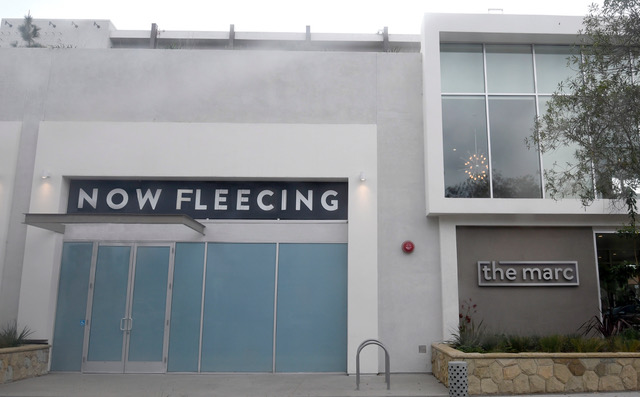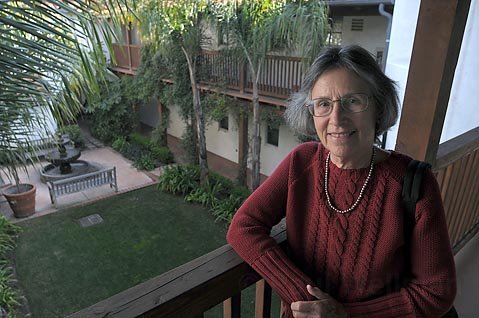Housing Density Realities
‘Affordable by Design’ Became ‘Market Rate’ Without an Affordability Requirement

officials felt when the building's rents turned out to be more than twice what was
expected of an AUD project.
A recent Independent article said I’d been “waging a lonely battle against increased housing densities for the past 10 years.” That is quite an ironic statement since I suggested in September 2010 that that an experiment be made by increasing density for rental units in a limited area of the city, an experiment that became the AUD (Average Unit-size Density) Incentive Program. The first project completed was The Marc. It had no affordability requirements, and its new Santa Barbara residents generated the need for even more lower-cost housing.
Five years before, in 2005, the city began preparation for a General Plan Update (GPU), a plan that lays out how the city would develop over the next 20 years. Some strongly believed that if densities were increased in central areas, it would be possible for developers to build market-rate affordable housing. Others strongly believed that the city didn’t have the resources for higher densities and that no changes should be made. (The environmental impact report for the GPU said that leaving densities as they were would be the environmentally preferable alternative.)
The council was at an impasse. There were numerous meetings — sometimes very stormy — of the council ad hoc GPU committee. It appeared as if there might not be a GPU.
In an effort to reach a compromise between those who wanted to increase density everywhere and those who didn’t want to increase density anywhere, I proposed that in a very limited part of the city’s commercial and light industrial areas densities be increased for rental projects. Units presumably would be less expensive by design.
The City Council accepted the suggestion. It decided that this experimental program would last until 250 rentals are completed or eight years had passed. It also greatly reduced parking requirements. The ordinance implementing the program was adopted in July 2013.
A new way to determine how many units per acre could be built was created: Average Unit-size Density (AUD). The smaller the units, the more could be built, up to a certain average size.
During the GPU process, people were asked what they loved about Santa Barbara. They said its small-town feel, diverse population, scenic beauty, distinctive architecture, preservation of historic character, and vibrant culture. The major problem was the lack of affordable housing.
This was not a new issue. One history noted that by 1930, the council’s weekly agenda contained measures to ease the housing crisis. A 1948 report said that the most pressing problem was a critical lack of affordable housing.
More than 25,000 additional dwelling units have been built since 1948, and the same problem continues. Maybe there never was a time in Santa Barbara without a housing crisis!
When I made the suggestion for the test program, I had in mind Casa de Las Fuentes, a beautiful Housing Authority project at Carrillo and Castillo streets. Its density is 57 dwelling units to the acre. High-density projects that fit within the community can be done well.
However, what the city got is The Marc, an 89-unit mixed-use development on upper State Street near La Cumbre Road. It is 63 units to the acre.
The Marc was the first high-density test program rental project to be completed. To my dismay, its rents began at $2,445 and went up to $4,100. This was more than twice what architects and developers in a design charrette said would be the starting point: $1,200.
I was naïve or just plain dumb. There is no such thing as affordable by design. Although land costs per unit are lower with higher density, rents will be whatever the market will bear.
Developers have found the program so attractive that another 62 units have been completed, and there are 492 units in the pipeline. Since no one anticipated this rush to build — no apartments had been built in Santa Barbara in decades — no mechanism had been created to call a halt to new applications.

concept, expecting a result more like Casa de las Fuentes' interior gardens and low rents;
the first AUD project, The Marc, delivered higher rents and greater amenities.
By summer 2016, even some members of the development community saw the need for affordability in the AUD incentive projects. I organized an ad hoc committee to seek ways to require that affordability in fall 2016. In December 2016, the City Council directed the establishment of a Housing Task Force to seek ways to improve the AUD incentive program.
To get affordability, it was necessary to require inclusionary (rent-restricted) units. Before adding any inclusionary requirements, state law requires a nexus study showing that the new market-rate residents’ needs create an additional demand for more low-income housing. That study confirmed the added demand and said that a requirement for up to 15 percent of the units to be rent-restricted could be supported.
The ordinance amendment for inclusionary units will be before the Planning Commission on March 7. Assuming it is adopted by the City Council, it will still be some months before it becomes effective. It could affect 217 units in the pipeline.
The AUD incentive program experiment has caused new rental units to be built; it has not provided the workforce-affordable units so badly needed.



